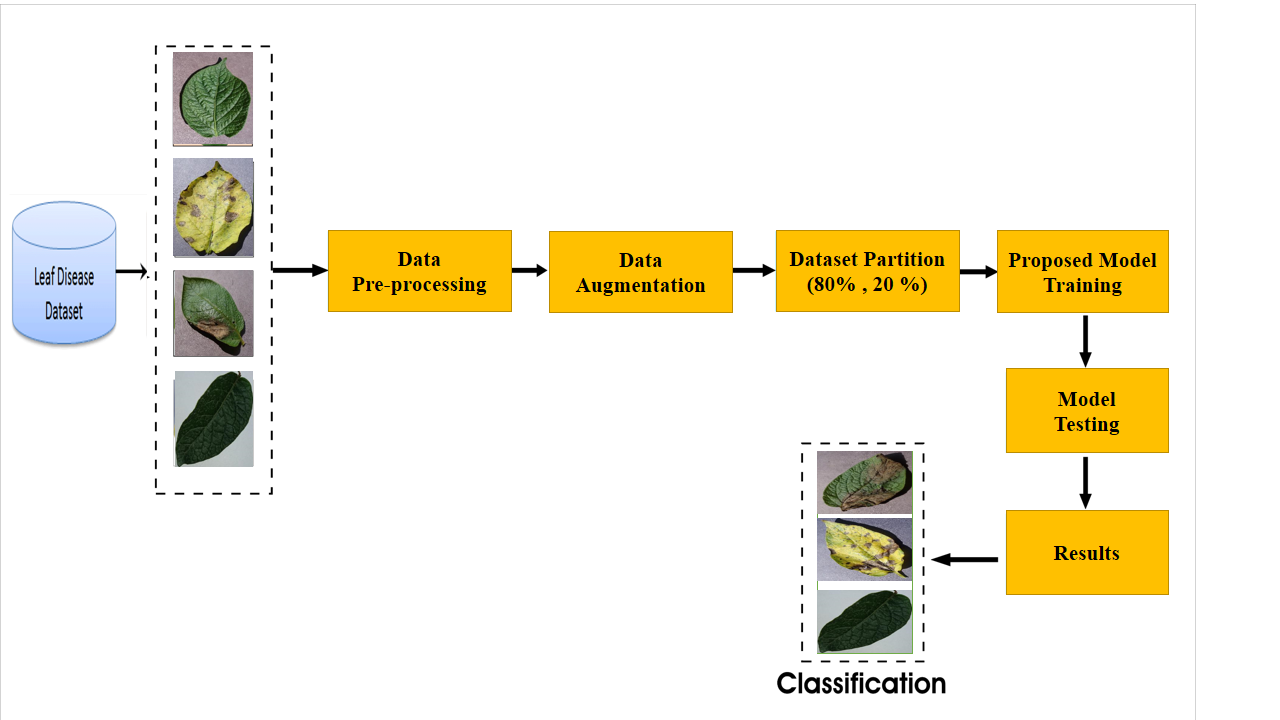Enabling Early Treatment: A Deep Learning Approach to Multi-Class Potato Leaf Disease Identification
Keywords:
Plant disease identification, Potato leaf Images, Image processing, Deep Learning, CNN, Transfer Learning, EfficientNetB2Abstract
Over 60% of the world's population largely depends on the agricultural sector for food, as indicated by previous studies, demonstrating the historical significance of agriculture as a means of survival. Plant infections, however, pose a serious problem that seriously reduces agricultural output. The annual loss of agricultural yield due to these diseases is roughly 25%. In this study, a novel lightweight Convolutional Neural Network (CNN) based on transfer learning is used to identify the early symptoms of potato leaf diseases. The proposed method comprises a collection of leaf images, performing image preprocessing and augmentation techniques on the data, which is then used to train a CNN model and evaluate the model's performance on new unseen images. The results of the experiment show that the CNN model accurately distinguishes the three types of potato leaf images: healthy, early blight, and late blight, with an overall accuracy of 97.33%. In order to ensure food security and reduce financial losses in agriculture, the recommended method might provide a reliable and efficient means of diagnosing potato infections. Even in the presence of serious illnesses, the model is still able to correctly identify the different disease types. This study shows how deep learning techniques can be used to classify potato diseases, adding automated and efficient disease management in potato cultivation.
References
Y. Kurmi, P. Saxena, B. S. Kirar, S. Gangwar, V. Chaurasia, and A. Goel, “Deep CNN model for crops’ diseases detection using leaf images,” Multidimens. Syst. Signal Process., vol. 33, no. 3, pp. 981–1000, Sep. 2022, doi: 10.1007/S11045-022-00820-4/METRICS.
F. Arshad et al., “PLDPNet: End-to-end hybrid deep learning framework for potato leaf disease prediction,” Alexandria Eng. J., vol. 78, pp. 406–418, Sep. 2023, doi: 10.1016/J.AEJ.2023.07.076.
U. Shruthi, V. Nagaveni, and B. K. Raghavendra, “A Review on Machine Learning Classification Techniques for Plant Disease Detection,” 2019 5th Int. Conf. Adv. Comput. Commun. Syst. ICACCS 2019, pp. 281–284, Mar. 2019, doi: 10.1109/ICACCS.2019.8728415.
M. H. Al-Adhaileh, A. Verma, T. H. H. Aldhyani, and D. Koundal, “Potato Blight Detection Using Fine-Tuned CNN Architecture,” Math. 2023, Vol. 11, Page 1516, vol. 11, no. 6, p. 1516, Mar. 2023, doi: 10.3390/MATH11061516.
R. G. Dawod and C. Dobre, “Upper and Lower Leaf Side Detection with Machine Learning Methods,” Sensors 2022, Vol. 22, Page 2696, vol. 22, no. 7, p. 2696, Mar. 2022, doi: 10.3390/S22072696.
B. Tugrul, E. Elfatimi, and R. Eryigit, “Convolutional Neural Networks in Detection of Plant Leaf Diseases: A Review,” Agric. 2022, Vol. 12, Page 1192, vol. 12, no. 8, p. 1192, Aug. 2022, doi: 10.3390/AGRICULTURE12081192.
A. Darwish, D. Ezzat, and A. E. Hassanien, “An optimized model based on convolutional neural networks and orthogonal learning particle swarm optimization algorithm for plant diseases diagnosis,” Swarm Evol. Comput., vol. 52, p. 100616, Feb. 2020, doi: 10.1016/J.SWEVO.2019.100616.
T. Sultana and M. Reza, “Identification of Potato Leaf Diseases Using Hybrid Convolution Neural Network with Support Vector Machine,” Commun. Comput. Inf. Sci., vol. 1781 CCIS, pp. 350–361, 2023, doi: 10.1007/978-3-031-35641-4_28/COVER.
A. Haidari and A. Kumar, “Potato Leaf Disease Detection Using the Convolutional Neural Network,” 14th Int. Conf. Electr. Electron. Eng. ELECO 2023 - Proc., 2023, doi: 10.1109/ELECO60389.2023.10416057.
U. Y. Tambe, D. A. Shobanadevi, D. A. Shanthini, and H.-C. Hsu, “Potato Leaf Disease Classification using Deep Learning : A Convolutional Neural Network Approach,” pp. 218–223, Sep. 2023, doi: 10.13052/RP-9788770040723.043.
Z. Wu et al., “Studies on Different CNN Algorithms for Face Skin Disease Classification Based on Clinical Images,” IEEE Access, vol. 7, pp. 66505–66511, 2019, doi: 10.1109/ACCESS.2019.2918221.
Z. Zhu, M. Jiang, J. Dong, S. Wu, and F. Ma, “PD-SegNet: Semantic Segmentation of Small Agricultural Targets in Complex Environments,” IEEE Access, vol. 11, pp. 90214–90226, 2023, doi: 10.1109/ACCESS.2023.3284036.
M. Ayaz et al., “Automatic Early Diagnosis of Dome Galls in Cordia Dichotoma G. Forst. Using Deep Transfer Learning,” IEEE Access, vol. 11, pp. 59511–59523, 2023, doi: 10.1109/ACCESS.2023.3283568.
N. Ullah, J. A. Khan, L. A. Alharbi, A. Raza, W. Khan, and I. Ahmad, “An Efficient Approach for Crops Pests Recognition and Classification Based on Novel DeepPestNet Deep Learning Model,” IEEE Access, vol. 10, pp. 73019–73032, 2022, doi: 10.1109/ACCESS.2022.3189676.
C. Shorten and T. M. Khoshgoftaar, “A survey on Image Data Augmentation for Deep Learning,” J. Big Data, vol. 6, no. 1, pp. 1–48, Dec. 2019, doi: 10.1186/S40537-019-0197-0/FIGURES/33.
M. Tan and Q. V Le, “EfficientNet: Rethinking Model Scaling for Convolutional Neural Networks”.
M. Ayaz, D. S. K. Shah, D. M. Javed, M. Assam, W. Khan, and F. Najeeb, “Automatic Vehicle Number Plate Recognition Approach Using Color Detection Technique,” Int. J. Innov. Sci. Technol., vol. 3, no. 4, pp. 166–176, 2021, doi: 10.33411/IJIST/2021030513.
“Enhancing Face Mask Detection in Public Places with Improved Yolov4 Model for Covid-19 Transmission Reduction | International Journal of Innovations in Science & Technology.” Accessed: Apr. 14, 2024. [Online]. Available: https://journal.50sea.com/index.php/IJIST/article/view/712

Downloads
Published
How to Cite
Issue
Section
License
Copyright (c) 2024 50SEA

This work is licensed under a Creative Commons Attribution 4.0 International License.

















